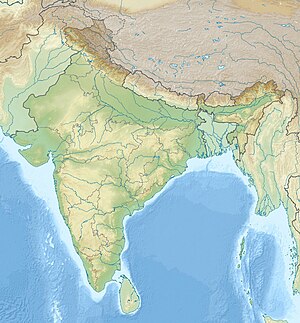Kankali Tila tablet of Sodasa
| Kankali Tila tablet of Sodasa | |
|---|---|
  The Kankali Tila tablet of Sodasa (photograph and drawing), with an inscription mentioning the year 42 of the reign of Northern Satraps ruler Sodasa.[1] | |
| Material | Red sandstone |
| Period/culture | 1st century CE |
| Discovered | 27°36′00″N 77°39′00″E |
| Place | Kankali Tila, Mathura, India. |
| Present location | State Museum Lucknow |
 Kankali Tila, Mathura, (Discovery) | |
The Kankali Tila tablet of Sodasa, also called the Iryavati stone tablet,[2] or Amohini ayagapata,[3] is a large stone slab discovered in Kankali (area of Mathura) which mentions the rule of the Northern Satraps ruler Sodasa in Mathura.[1] The tablet in the State Museum Lucknow (room J.1).[2] It is an important example of Mathura art.
Description[]
This votive tablet, which is essentially an ayagapata, though not so called, represents a royal lady attended by three women and a child. The attendant women, in accordance with the ancient Indian fashion, are naked to the waist. One holds an umbrella over her mistress, whom another fans. The third holds a wreath ready for presentation. The execution is bold, and quite artistic.[1]
Inscription[]
The tablet bears a three line epigraph mentioning that in the year 42 of "the Lord, the Great Satrap Sodasa" (![]()
![]()
![]()
![]()
![]()
![]()
![]()
![]()
![]()
![]()
![]()
![]() Svamisa Mahakṣatrapasa Śodasa) a monument for worship was set up by a certain Amohini.[1] The text is as follows :
Svamisa Mahakṣatrapasa Śodasa) a monument for worship was set up by a certain Amohini.[1] The text is as follows :
L1. Nama arahato Vardhamanasa
2. Sv[a]misa mahakshatrapasa Sodasasa savatsare XL(?)II hemantamase II divase IX Haritiputrasa Palasa bhayaye samasavikaye
3. Kochhiye Amohiniye saha putrehi Palaghoshena Pothaghoshena Dhanaghoshena Ayavati pratihapita praya[bha]
4. Aryavati arahatapujaye.
"Adoration to the Arhat Vardhamana! In the year 42 of the Lord, the Mahakshatrapa Sodasa, in the second month of winter, on the 9th day, an Ayavati (Aryavati) was set up by Amohini (Amohint), the Kochhi (Kautsi), a female lay-disciple of the ascetics (and) wife of Pala, son of a Hariti (Hariti or Hariti mother), together with her sons Palaghosha, Pothaghosha and Dhanaghosha .... the Aryavati (is) for the worship of the Arhat."
Question of the date[]
The inscription shows that the tablet was presented to the Jain shrine by a lady named Amohini in the year 42 or 72, in the reign of the Great Satrap Sodasa. The first numerals for the date may be read as 40, or possibly 70 (according to Buhler), so that the regnal date could be either 42 or 72 (with 72 being favoured by most).[1][5]


